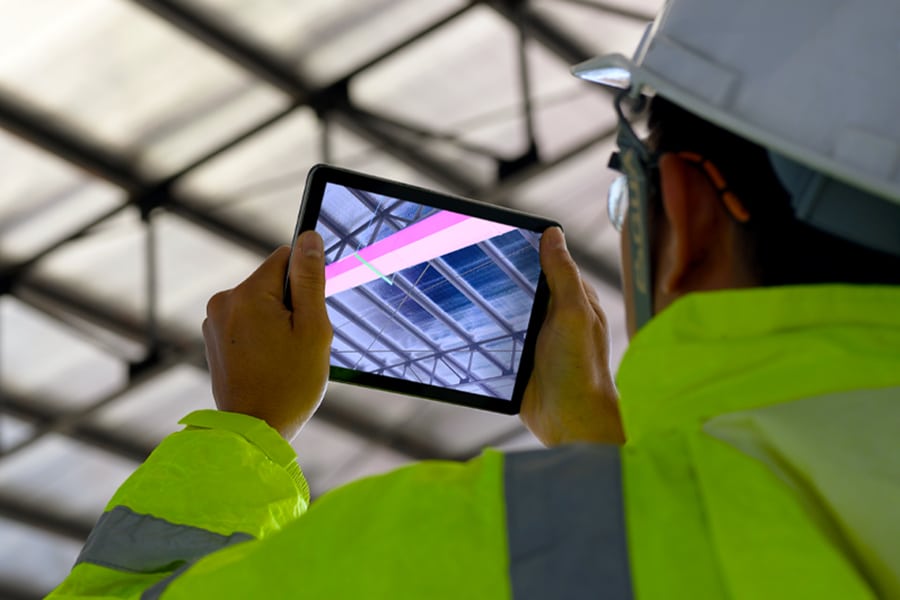How might ever-evolving technology enhance the productivity and efficiency of the construction industry beyond what we already know it can achieve in the form of things like modular and off-site manufacturing?
A growing number of people look to the development of construction in the metaverse as a pointer to how things might turn out.
Facebook’s Mark Zuckerberg has gone on record saying he believes the so-called metaverse is the future of the internet. He even re-named his company Meta Platforms Inc., showing his faith in the concept.
In fact, last year “metaverse” took second place in the Oxford University Press’ “Word of the Year,” no doubt assisted by Facebook’s move.
But what is the metaverse? And where does it come from?
Making sense of the metaverse
While alternate realities have been discussed for decades, the metaverse concept was created in 1992 in a science fiction novel called “Snow Crash” by Neal Stephenson.
In his book, Stephenson describes a futuristic, dystopian world where anyone in their right mind reverts to living in a virtual reality computer-generated universe.
Extending from the online gaming world, the metaverse is evolving—so a growing number of people hope—to become part of a new digital economy. But it’s still complicated and tough to nail down.
The metaverse has evolved to the extent that for some it equates to a way of looking at cyberspace. As tech watchers point out, the metaverse “isn’t one specific type of technology, but rather a broad (and often speculative) shift in how we interact with technology.”
The metaverse can encompass virtual worlds and realities, as well as augmented ones. Sounds a bit vague, but then that’s part of its appeal; it transcends what we usually think of in terms of both the internet and interactive connectivity.
What can we do in the metaverse?
Definitions certainly vary. But whatever one’s take on it, in the real world the metaverse is seen as a space where pretty much anything—including construction—can be done. Technology training organisation 101Blockchains says, “the metaverse has been described with multiple definitions depending on how people perceive the technology,” although it adds that, “the world does not have a completely developed metaverse right now.” Herein lies the rub.
Yet while it has to be fully fleshed out, the metaverse is already making a considerable impact on the “real” world around us. If you own a non-fungible token, use a virtual headset or deal in cryptocurrency, you are already part of the metaverse, according to deVere Group.
It goes on: “Simply put, a metaverse blurs the line between real and virtual life. It is a virtual world or space that you can enter, ‘live’ and participate in using virtual and augmented reality headsets or glasses. It can include aspects of social media, online gaming and cryptocurrencies to allow users to interact.”
For some, the components of the metaverse—starting with online gaming and other interactive developments, such as online casinos—will evolve and eventually create the sort of virtual world that millions of people want to dive into and inhabit.
Uses of the metaverse in construction
How can the metaverse positively impact construction? In the years before construction in the metaverse became a possibility, digital technology has been a friend to the sector. First computer-aided design (CAD), then building information modeling (BIM). Lately, virtual reality (VR) and augmented reality technologies have found their way into a number of design and engineering studios.
Given the pressing need for the sector to increase productivity, boost quality, enhance its green credentials and provide a safe working environment, it isn’t surprising that interest in what the metaverse could achieve is growing.
According to one estimate, nearly half of the major architecture practices around the world use VR. This technology seems to be the gateway into the metaverse in construction projects, bridging the reality gap between the design stage, “on paper,” and what is actually happening on the ground.
Disparities can be addressed, according to Parametric Architecture, creating “realistic expectations and help[ing] in inculcating the experiential value of the space accurately right from the pitch stage.”
So perhaps the metaverse as described by Facebook’s Zuckerberg and other proponents of the technology isn’t going to envelop construction in the way it has the gaming community.
Nonetheless, the implementation of construction in the metaverse will be transformative in helping to plan, design, view and experience the projects being created in advance of and during the delivery phase beyond what is achievable now.
Is the future of construction in the metaverse?
As Leonard, an offshoot of French construction giant Vinci, succinctly puts it, the metaverse is “somewhere between new frontier and augmented BIM.” Vinci suggests the metaverse has the potential to extend BIM’s track record of creating new roles in construction’s digital sphere.
“The metaverse is making promises concerning the future of work in the construction industry,” it says. “Once again, it’s a question of pushing BIM’s potential to the max by offering more immersive environments capable of facilitating remote collaboration.”
It’s the impact of such digital technology, according to Vinci, that offers such considerable upside. “Building in the metaverse intuitively represents a considerable saving in energy and raw materials: digital administrations, virtual showrooms and offices in VR consume less than the real-life construction industry.”
While people can’t live in virtual buildings, the development of the technology will take on new hues, some as yet to be fully fleshed out.
The path from CAD to the obvious benefits of BIM and digital twins will be further laid down by the coming generations of technology experts who will develop scenarios beyond current understanding.
There will increasingly be those in the construction industry who recognise the potential of metaverse-type systems. And when these can deliver projects in a way that significantly reduces the sort of inefficiencies, cost overruns and waste so familiar to those responsible for the built environment, then the metaverse will be a force to be reckoned with.











